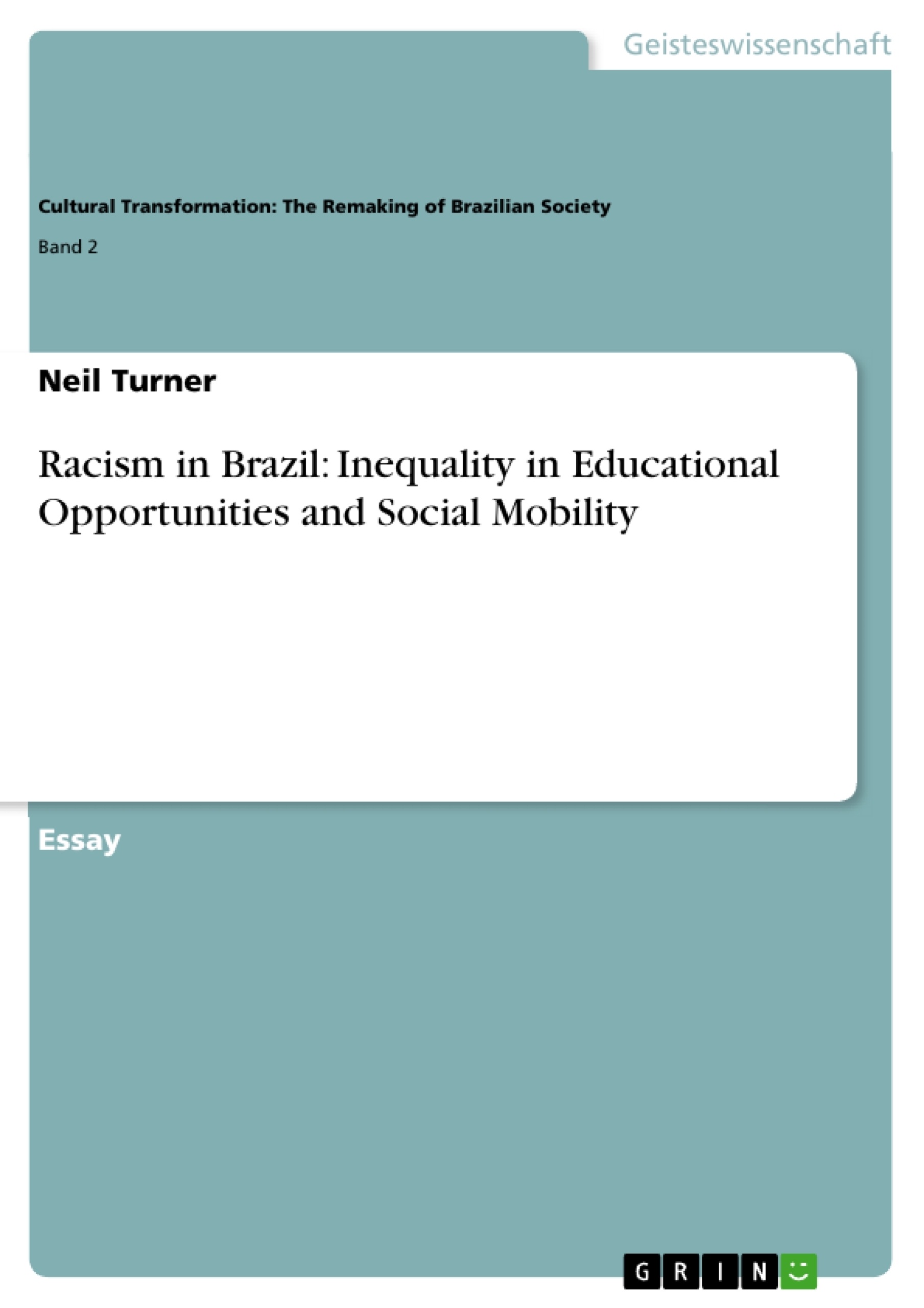This paper presents an overview of the debate on race relations in Brazil. The main focus of this work is to examine inequality of opportunities between whites and nonwhites and how class and racial discrimination impacts outcomes for social advancement. Although many scholars, intellectuals and authors have contributed to an analysis of this debate, race relations in Brazil remains a very confounding and provocative issue. The rapid and tremendous growth that Brazil is currently experiencing has brought increased stratification between races and classes and a recurrence of the public debate on this complex issue. This paper will trace the history of this debate, the myth of racial democracy, the Afro-Brazilian militant movement and provide a brief overview of the existing quantitative research on Brazilian race relations.
Inhaltsverzeichnis
- Racism in Brazil: Inequality in Educational Opportunities and Social Mobility
- History behind the Debate
- The Myth of Racial Democracy
- Black Militants and Racial Awareness
- Disadvantages in Education and Social Advancement
- Conclusions
- Notes
- Bibliography
Zielsetzung und Themenschwerpunkte
Diese Arbeit bietet einen umfassenden Überblick über die Debatte über die Rassenbeziehungen in Brasilien. Der Schwerpunkt liegt auf der Untersuchung der Ungleichheit der Chancen zwischen Weißen und Nicht-Weißen und darauf, wie Klassen- und Rassendiskriminierung die Ergebnisse für den sozialen Aufstieg beeinflusst. Obwohl viele Wissenschaftler, Intellektuelle und Autoren zu einer Analyse dieser Debatte beigetragen haben, bleiben die Rassenbeziehungen in Brasilien ein sehr verwirrendes und provokantes Thema. Das rasante und enorme Wachstum, das Brasilien derzeit erlebt, hat zu einer verstärkten Schichtung zwischen den Rassen und Klassen und einem Wiederaufleben der öffentlichen Debatte über dieses komplexe Thema geführt. Diese Arbeit wird die Geschichte dieser Debatte, den Mythos der Rassendemokratie, die afrobrasilianische militante Bewegung nachzeichnen und einen kurzen Überblick über die vorhandene quantitative Forschung zu den brasilianischen Rassenbeziehungen geben.
- Rassendiskriminierung in Brasilien
- Soziale Mobilität und Ungleichheit
- Bildungschancen und soziale Ungleichheit
- Der Mythos der Rassendemokratie
- Die afrobrasilianische militante Bewegung
Zusammenfassung der Kapitel
- Racism in Brazil: Inequality in Educational Opportunities and Social Mobility
Die Arbeit beginnt mit einem einleitenden Szenario, das die Lebensbedingungen eines jungen afrobrasilianischen Mädchens namens Luciana schildert, die aus einer armen Familie stammt und trotz ihres großen Ehrgeizes, Ärztin zu werden, mit erheblichen Herausforderungen konfrontiert ist. Die Arbeit stellt die These auf, dass die soziale Herkunft und die Rassendiskriminierung in Brasilien die Bildungschancen und den sozialen Aufstieg für Afro-Brasilianer erheblich behindern.
- History behind the Debate
Dieses Kapitel beleuchtet die historische Entwicklung der Rassenbeziehungen in Brasilien, beginnend mit der Kolonialzeit und der Sklaverei. Es wird hervorgehoben, dass die intensive Miscegenation, die durch den Mangel an europäischen Frauen und die Beziehungen zwischen portugiesischen Männern und indigenen Frauen und afrikanischen Sklaven entstand, zu einer stark gemischten Rassenstruktur führte. Das Kapitel analysiert die Rolle der Assimilationspolitik, die darauf abzielte, die brasilianische Bevölkerung durch die Förderung der europäischen Einwanderung und die Vermischung aufzuhellen, um die soziale und politische Macht der weißen Elite zu stärken. Es wird auch die Entwicklung des Konzepts der "wissenschaftlichen Rassenlehre" und seine Auswirkungen auf die brasilianische Gesellschaft untersucht.
- The Myth of Racial Democracy
Dieses Kapitel befasst sich mit dem umstrittenen Konzept der "Rassendemokratie", das von einigen als Beweis für die friedliche und harmonische Integration von Rassen in Brasilien angesehen wird. Es werden jedoch auch die kritischen Stimmen beleuchtet, die argumentieren, dass der Begriff der Rassendemokratie eher ein Mythos ist, der dazu dient, die anhaltende Diskriminierung und Ungleichheit zu verschleiern. Das Kapitel untersucht die unterschiedlichen Perspektiven auf die Rassendemokratie, die von Gilberto Freyre, Florestan Fernandes und anderen bedeutenden brasilianischen Soziologen vertreten werden. Es werden auch die Forschungsergebnisse der UNESCO-Studien aus den 1950er Jahren diskutiert, die die Existenz von Rassendiskriminierung in Brasilien aufdecken.
- Black Militants and Racial Awareness
Dieses Kapitel beschreibt die Entstehung und Entwicklung der afrobrasilianischen militanten Bewegung, die sich gegen den Mythos der Rassendemokratie und für die Anerkennung der Rassendiskriminierung in Brasilien einsetzte. Es werden die wichtigsten Akteure und ihre Beiträge zur Bewegung, wie Abdias do Nascimento, Florestan Fernandes und Roger Bastide, vorgestellt. Das Kapitel erläutert die Strategien der Bewegung, die auf die Sensibilisierung für die Rassendiskriminierung und die Erlangung von Rechten für Afro-Brasilianer abzielten. Es wird auch die Bedeutung des Gesetzes von 1988 hervorgehoben, das Rassismus in Brasilien zu einem Verbrechen erklärte.
- Disadvantages in Education and Social Advancement
Dieses Kapitel konzentriert sich auf die Auswirkungen von Rassendiskriminierung auf die Bildungschancen und die soziale Mobilität in Brasilien. Es werden die Ergebnisse quantitativer Studien aus den 1970er Jahren und später vorgestellt, die belegen, dass Afro-Brasilianer in der Bildung und im Arbeitsmarkt benachteiligt sind. Das Kapitel analysiert die verschiedenen Theorien, die versuchen, die Rassenbeziehungen in Brasilien zu erklären, wie die von Pierson, Costa Pinto, Fernandes und Hasenbalg. Es werden auch die Ergebnisse von Studien über die Auswirkungen von Klasse und Rasse auf den Bildungserfolg und die soziale Mobilität untersucht.
Schlüsselwörter
Die Schlüsselwörter und Schwerpunktthemen des Textes umfassen Rassismus, Ungleichheit, Bildungschancen, soziale Mobilität, Rassendemokratie, Afro-Brasilianer, Klassenstruktur, Diskriminierung, Brasilien, Geschichte, Sozialwissenschaften, quantitative Forschung.
- Quote paper
- Dr. Neil Turner (Author), 2011, Racism in Brazil: Inequality in Educational Opportunities and Social Mobility, Munich, GRIN Verlag, https://www.grin.com/document/178998



